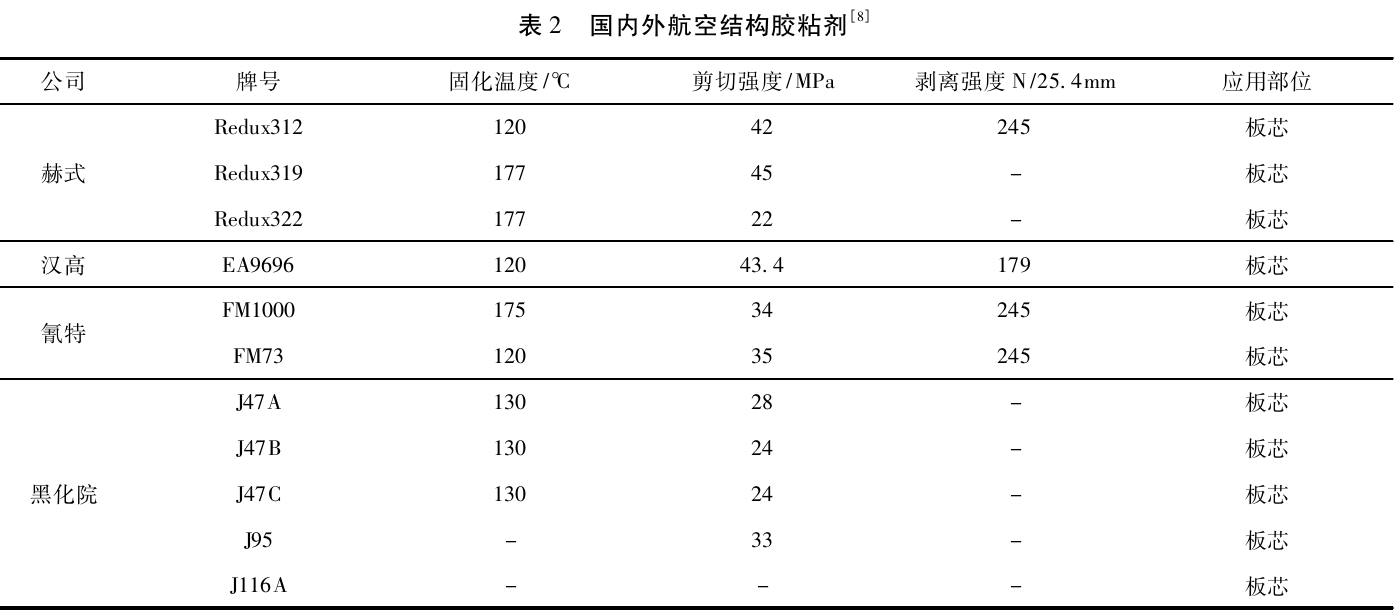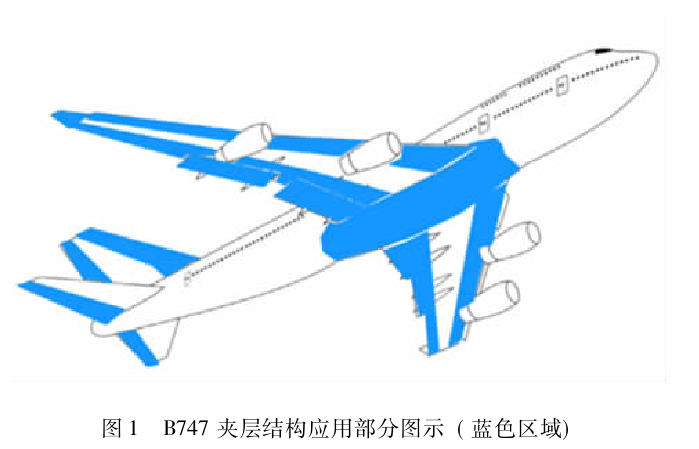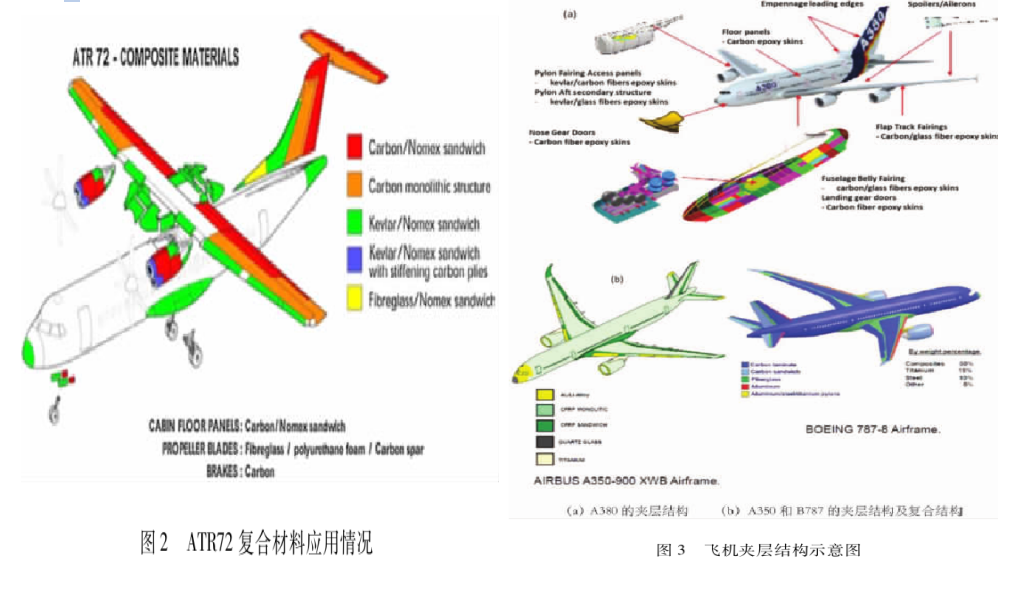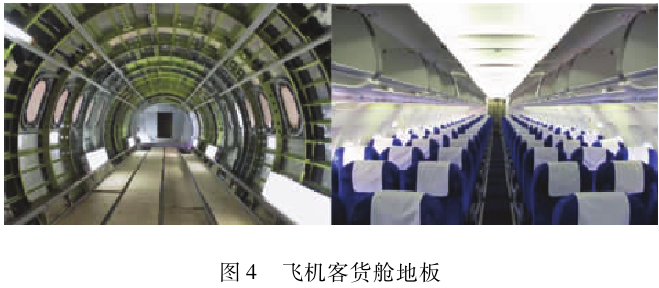Application of Composite Honeycomb Sandwich Structure in Civil Aircraft
2024/01/23
Abstract: Composite honeycomb sandwich structures have the characteristics of high strength, high specific stiffness, low density, good compressive and bending resistance, and are widely used in the field of civil aircraft. The application areas include the fuselage, engine hood, fairing, cabin door, antenna hood, leading edge, etc. The widespread application of honeycomb sandwich structures has significantly reduced the weight of aircraft structures. With the advancement of molding technology and the improvement of material properties, honeycomb sandwich structures are gradually being applied to main load-bearing structures such as floors. This article first analyzes the research progress and development process of honeycomb sandwich structures. Secondly, the application of honeycomb sandwich structures on typical aircraft components was summarized. Finally, the current application status of honeycomb sandwich structures on civil aircraft floors was introduced.
With the development of the social economy, the transportation sector, especially the aviation sector, is facing two tasks: overall structural weight reduction and the directly related benefit issue of weight reduction - reducing fuel consumption. Structural weight and fuel consumption are particularly important in the aviation industry. At present, honeycomb sandwich structures have been widely used in the aviation industry, with main application components including fuselage, cabin doors, wings, tail wings, floors, fairings, and radar covers. The honeycomb sandwich structure provides a good strength to weight ratio. Compared with composite skin, they perform better under lateral and bending loads, thanks to their structural form, which is a thick and light core surrounded by two thin and hard layers.
The widespread application of honeycomb sandwich structures has significantly reduced the weight of aircraft structures. Thanks to their excellent compressive and bending performance, honeycomb sandwich structures are gradually developing towards main load-bearing structures such as floors. This article is mainly divided into three parts. Firstly, it analyzes the research progress and development process of honeycomb sandwich structures; Secondly, the application of honeycomb sandwich structures on typical aircraft components was summarized based on the current aircraft models used. Finally, the current application status of honeycomb sandwich structures on civil aircraft floors was introduced.
Honeycomb sandwich structure
Honeycomb sandwich structures originated from bionics. Compared with solid materials of the same type, honeycomb sandwich structures have the characteristics of high specific strength, high specific stiffness, and light weight. Therefore, they have been widely used in aerospace, transportation, and other fields. Composite honeycomb sandwich structures can effectively improve bending stiffness and enhance the ability to withstand bending moments and pressures with minimal weight increase, making them an ideal lightweight structure for aerospace.
The composite honeycomb sandwich structure mainly consists of three parts: panel, honeycomb core, and adhesive.
(1) Panel. The panel in the sandwich structure is the main load-bearing part, and compared to the core material, the panel material has the characteristics of high density, high modulus, and high strength. The panel materials for composite sandwich structures are usually aluminum alloy, titanium alloy, fiberglass, and other materials. At present, most of the unidirectional tapes or fabric composite materials used in aviation structures are carbon fiber or glass fiber.
(2) Honeycomb core. The performance of honeycomb sandwich structures and the geometric shape of the honeycomb are related to the material of the honeycomb core. Generally, aluminum honeycomb core, aramid paper honeycomb core, fiberglass honeycomb core, etc. can be used according to the material. Aramid paper honeycomb can be divided into meta aramid paper honeycomb and para aramid paper honeycomb according to their types. Meta aramid paper honeycomb is a type of meta aramid obtained by interfacial condensation or low-temperature solution condensation of meta phthaloyl chloride and meta phenylenediamine. The most common one on the market is meta aramid, which was first invented and put into use by DuPont in the 1960s. Para aramid paper honeycomb is a product of the condensation of p-phenylenediamine and p-phenylenediamine chloride to obtain para aramid, with the trade name Kevlar. The existing aramid paper honeycomb core mainly consists of meta aramid, with very little research on para aramid. The main application models are shown in Table 1. Aramid paper honeycomb, also known as NOMEX honeycomb, is made by impregnating aramid paper with phenolic resin. Compared with aluminum honeycomb, aramid paper honeycomb has a much stronger ability to resist local instability, because the honeycomb wall of aramid paper honeycomb is thicker than that of aluminum honeycomb. The preparation of Nomex honeycomb consists of nine processes: aramid paper coating, lamination, pressing, cutting, stretching, shaping, impregnation, curing, and slicing. AVIC Composite Materials Co., Ltd. has improved the impregnation process of aramid paper honeycomb, summarized process parameters such as pore size and paper thickness, and derived an empirical formula for density control. Suzhou Fanglei Honeycomb Composite Materials Co., Ltd. uses domestically produced aramid paper to prepare honeycomb, and the compressive and shear properties can meet the requirements of HB5435-89 and BMS8-124. The dielectric and flame retardancy also meet the standard requirements. Meishida Company, a subsidiary of China Yantai Spandex Group Co., Ltd., has prepared different types of honeycomb cores from its meta aramid paper through a series of mature process flows. The planar compressive and shear resistance of its core material and sandwich structure at room temperature can meet the index values of Boeing BMS8-124 standard, and can meet the requirements of mechanical performance.

(3) Adhesive. The adhesive used for aviation honeycomb sandwich structures is usually structural adhesive, which refers to the adhesive that can withstand considerable force in the usage environment within a predetermined time, and has strength and durability that matches the adhesive. According to the resin matrix, it is generally divided into three categories. The first type is epoxy, which has the advantages of excellent processability and long applicability, with a maximum temperature resistance of 232 ℃; The second type is bismaleimide, which can reach temperatures above 232 ℃ and is mainly used on military aircraft with higher temperatures; The third type is cyanate esters, which have excellent temperature and dielectric properties, as well as moisture and heat resistance. Therefore, they are mainly used in components with electrical performance requirements. The commonly used epoxy resin structural adhesives in aviation are shown in Table 2. American companies such as Hershey and Cyanote have developed various material systems for various purposes. In recent years, domestic companies such as AVIC Composite have also developed medium and high temperature resin systems, such as BA9913, BA9916, SY-24C-300, etc.

Application of Honeycomb Sandwich Structure on Typical Aircraft Components
As for large civilian aircraft, the design of the Boeing 747 (first flight on February 9, 1969) adopted a large proportion of sandwich structures (Figure 1). Its wing surface is approximately half, including the leading and trailing edges, made of fiberglass and Nomex honeycomb. In the Boeing 747, the fuselage cylindrical shell is mainly composed of Nomex honeycomb, and the floor, side panels, elevated trash cans, and ceiling are also honeycomb structures. Most flaps are made of the same honeycomb structure, but aluminum honeycomb and skin are also used. The application of honeycomb sandwich structure on B787 includes rudder, elevator, wingtip, engine compartment, and other parts. The engine nacelle and thrust reverser device use HexWeb honeycomb and HexPly8552/AS4 prepreg. HexWeb honeycomb has the advantages of light weight, high stiffness, and sound absorption function, and has been used by major engine manufacturers around the world. Only 8% of the Boeing 707 is honeycomb structure, while the newer Boeing 757/46 honeycomb structure accounts for 46%.

The application of honeycomb sandwich structure in large civil aircraft was first applied to the rudder of Airbus A310 aircraft, and later used for the rudder of A320 and A340 aircraft. The largest honeycomb sandwich structure rudder is the A340 rudder, with a honeycomb sandwich structure area of 15.3m2. The A380 aircraft has the largest single machine usage, with a honeycomb sandwich structure of 4000m2, mainly used for large-sized structural components such as abdominal fairings and floors, and the floor is mainly made of M C. Gillfab4909 sandwich panel from GillCorp, with Kevlar honeycomb as the core material. The floor structure of the Airbus A380 is extensively made of Nomex honeycomb sandwich composite materials. The excellent materials enable the A380 to have an operating life of up to 20000 hours, ensuring that the aircraft can serve for more than 10 years. Afterwards, the use of composite materials significantly increased, especially the ATR72, the first civilian aircraft with carbon basic structure (wing box) certification (see Figure 2). As shown in Figure 3, the proportion of sandwich materials in the secondary structure has been decreasing. For the A380, Boeing 787, or Airbus A350, only the belly fairing, cabin, and front landing gear doors, some ailerons, and rudder are still made of sandwich structures, while the rest are self reinforcing integral structures.

Compared with large civilian aircraft, the application of honeycomb sandwich structures in general aircraft mainly manifests in their use on the fuselage, such as HawkerBeechcraft's PremierI, Hawker 4000 and Prime Minister IA aircraft, Bombardier Aerospace's Lille 85 aircraft, etc. Among them, PremierI is the first FAA certified fully composite jet business aircraft. The entire fuselage adopts a honeycomb sandwich structure with carbon fiber panels, with an overall thickness of 20.6mm. The fuselage has no trusses or frames, reducing weight by 25% compared to traditional aluminum structures and increasing cabin space by 13%. The current production of the Hawker 4000 aircraft consists of three cylinder structures connected at the wings. The cylinder is a honeycomb sandwich structure, and the skin is laid using MAG Cincinnati's Viper automatic wire laying machine. Russia has extensively applied Nomex honeycomb sandwich composite components to aircraft components such as flaps, ailerons, fuselage panels, engines, cockpits, cargo holds, horizontal tails, wing leading edges, and helicopter rotor tail beams.
A certain aircraft model produced by AVIC Harbin Aircraft Industry Group Co., Ltd. and other units in China extensively uses resin based composite materials (such as vertical tails, propeller blades, flat tails, and rotors) and Nomex honeycomb sandwich structural composite materials (fuselage panels, floors, tail beams, etc.), which significantly reduces the weight of the overall fuselage, improves the fatigue strength of components, improves aerodynamic characteristics, and thus enhances the flight quality of helicopters. According to statistics, in addition to the engine and transmission system, nearly 300 aircraft components are made of Nomex honeycomb sandwich structure composite materials, using 3 densities and 12 specifications of Nomex honeycomb core materials. The total amount of Nomex honeycomb core materials used in the overall fuselage exceeds 200m2, accounting for about 80% of the overall fuselage area. It is currently one of the most commonly used Nomex honeycomb sandwich structure composite materials in China.
The Application of Honeycomb Sandwich Structure on Civil Aircraft Floors
4.1 Current research status of aircraft cabin floor
The traditional aircraft floor and cargo compartment floor are made of metal structure, with hundreds of rivets and screws on each floor, and require elastic pads to isolate from the fuselage structure, resulting in high costs. The use of composite materials can greatly improve the strength, stiffness, fatigue, and corrosion resistance of floor structures, reduce the number of connectors by an order of magnitude, and significantly reduce the weight of floor structures.
The panel of aircraft floor composite sandwich structure is usually made of fiberglass prepreg, carbon fiber, and Kevlar prepreg, with epoxy resin or phenolic resin as the matrix. Nomex honeycomb is commonly used for honeycomb cores.

4.2 Application of sandwich structure on flooring
The main cabin floor of the Boeing 234 civilian Chinook helicopter has a size of 2.5m per piece × 2.2m, consisting of 4 pieces in total. The panel is made of fiberglass/Kevlar49 composite material, with a Nomex honeycomb core. The upper and lower panels of the sandwich floor have four layers each, symmetrical to the honeycomb core in the middle. 1、 The second layer is made of 0 ° glass fiber prepreg, and the third and fourth layers are made of Kevlar49 fiber prepreg in the 0 ° direction. The Nomex core has a height of 38mm, a grid edge length of 2mm, and a density of 48kg/m3. The panel and core are bonded with EA9 adhesive film. The cabin floor of aircraft models such as Boeing 777 and Boeing 787 Dreamliner also uses composite sandwich structures.
M. The Gillfab4223 sandwich structure panel produced by C. GillCorp is made of fiberglass fabric, with a phenolic resin matrix and GillcoreHD honeycomb core. The adhesive film is made of epoxy system. The thickness of the entire sandwich structure is 12.6mm, with an upper panel thickness of 1.27mm and a lower panel thickness of 0.508mm. The Gillfab4223 sandwich structure is applied to Airbus A318/A319/A320/A321/A330/A340/A300/A310/A300-600. M. The Gillfab4505 sandwich structure panel produced by C. GillCorp uses carbon fiber unidirectional tape (with a surface layer of glass fiber prepreg), the matrix is phenolic resin, the core is GillcoreHD honeycomb, and the adhesive film is made of epoxy system. The thickness of the entire sandwich structure is 9.5mm, and the thickness of the upper and lower panels is 0.5mm. The Gillfab4505 sandwich structure is applied to the Airbus A318/A319/A320/A321/A330/A340.
The cargo hold floor structure of the Fokker 100 aircraft is relatively simple, which is a composite sandwich structure. The external skin is made of high-performance thermoplastic composite panels, and the sandwich is made of Nomex honeycomb. The skin and core are bonded with epoxy film.
Niu Fangxu and others from Beijing Fiberglass Institute Composite Materials Co., Ltd. used self-made glass fiber reinforced phenolic resin prepreg as panel raw material to prepare a certain model of Nomex honeycomb sandwich structure cargo hold floor through hot pressing. The system evaluated the mechanical and flame retardant properties of the floor, analyzed the effects of prepreg type, curing temperature, and molding process on the mechanical properties of honeycomb panels, and studied the influencing factors of flame retardant properties of honeycomb panels. The results show that the mechanical properties of the cargo hold floor prepared with self-made pre impregnated materials are excellent. The bending ultimate load of the long beam can reach 4348N, and the deflection at a load of 445N is only 6.79mm. The impact performance can reach 17.1J, and the drum peel strength can reach 66.4N · mm/mm. At the same time, it meets strict flame retardant requirements and can achieve the localization replacement of floor materials in aircraft bulk cargo hold areas.
epilogue
Honeycomb sandwich structures have the characteristics of high strength, high specific stiffness, and low density. Thanks to their excellent compressive and bending performance, they have been widely used in the field of civil aircraft. This article analyzes the research progress and current development status of honeycomb sandwich structures, and further summarizes their application in typical aircraft structures. It is believed that with the development and production of domestic aircraft C919/C929, composite sandwich structures for aircraft floors have broad application prospects.
(Source: Fiber composite materials)

